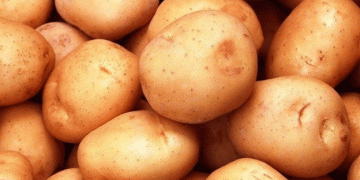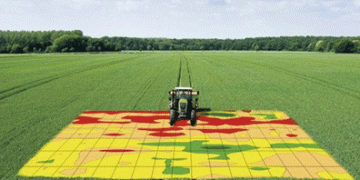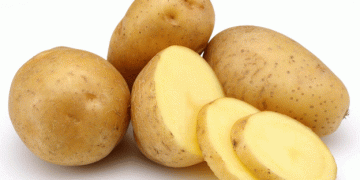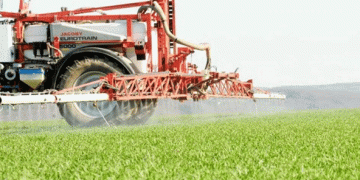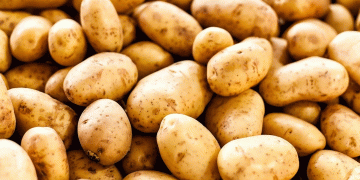Eugenia Banks of the Ontario Potato Board has created a resource on late blight, updated for the 2021 growing season.
The start of this week saw some much-needed rainfall, and the next few days will see a great deal more moisture, which means conditions are ripe for late blight. As Banks says, a rapidly expanding canopy provides more foliage for spores to land and initiate infections when blown in by the wind that accompanies storms. The 2021 Summer Checklist for Late Blight has been included below, courtesy of Banks.
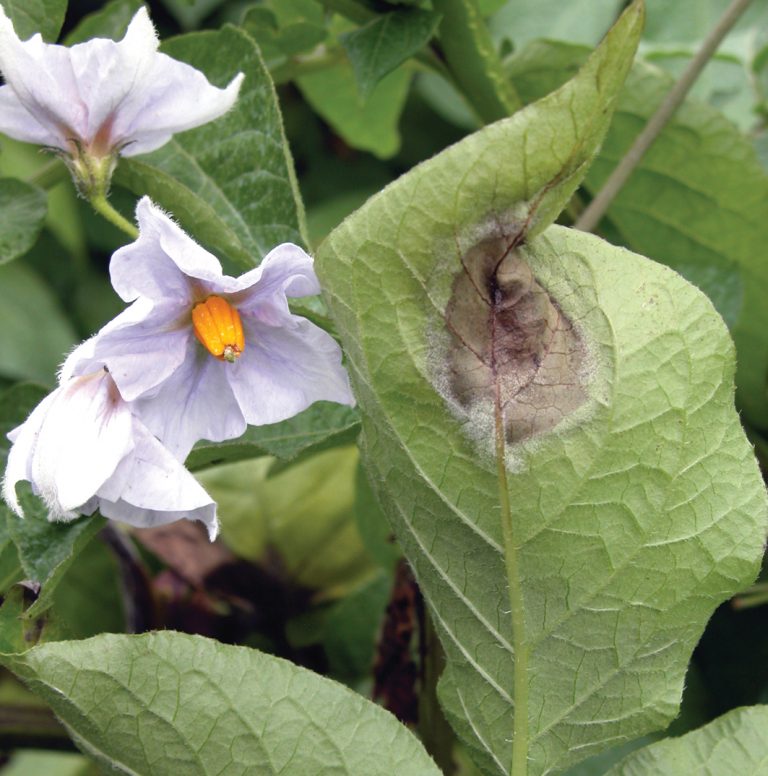
Early Summer
Field Scouting. Start your scouting program before the crop emerges. This will allow scouts to become familiar with field characteristics, such as low spots and changes in soil texture.
Risky areas that should always be monitored are:
- Low lying areas that tend to be wet for long periods after rainfall.
- Compacted areas.
- Rows close to tree lines.
- Field edges along creeks or ponds.
- Pivot centre points and pivot wheel tracks. Look closely at the plants under the first tower of centre pivots – this area remains wet longer than areas farther out on the boom. Also, wheel-track areas usually remain damp or wet after other parts of the field have dried up.
- Weedy areas.
- Windward sides of fields. Windborne spores may blow in and infect here.
- Any area that is protected from the wind where leaves tend to remain wet longer.
Sanitation practices for scouts
- Scouts should monitor late blight-infested fields last.
- Scouts should wear disposable suits, gloves and boot covers to scout infested fields. The suits, gloves and boot covers should be removed, turned inside out, and stuffed into a garbage bag for disposal.
Make sure there are no cull piles in your farm. Late blight is a community disease. A single cull pile can cause an epidemic with serious economic losses for many growers. Monitor sites where cull potatoes were buried and eliminate any volunteer potatoes.
Be aware of home gardens with alternate hosts near your fields. Tomatoes, peppers, eggplants and some petunia spp. are hosts of late blight. Explain to your neighbours that late blight can spread easily from gardens to commercial fields, causing serious economic losses. Plants infected with late blight in home gardens should be destroyed immediately after symptoms are visible.
Start your fungicide program early
- Begin a fungicide program early, when plants are 12 to 15 centimetres (cm) tall;
- Alternate fungicides from different chemical groups to delay the development of resistance;
- Spray cymoxanil (Curzate) at 80 per cent emergence if the field is at high risk of late blight;
- Use short application intervals if disease pressure is high.
Be aware of the bi-weekly spore trapping results for your area. If late blight sporangia are detected by spore traps, include late blight specific fungicides in your spray program.
Keep new growth protected. New growth is a good target for late blight, especially the growing point where water persists for longer periods after a rain.
Try to achieve good spray coverage. Calibrate your sprayer and use a volume of water that will ensure even coverage of the canopy.
Monitor last year’s potato fields for volunteers. Volunteer potato plants are common where trash or snow keeps the soil from freezing. Use labeled broadleaf herbicides where possible to suppress the growth of volunteer potatoes in cereal crops.
Destroy hot spots. If late blight is found in a localized spot, destroy all diseased plants plus a six-foot border of surrounding plants. Pull and bag the diseased plants, spray them with an herbicide, or disc the area. If you decide to disc the hot spot, spray the crop with a fungicide before doing it to avoid spreading spores on farm equipment while driving out of the field. Pressure wash the equipment when finished.
Mid-summer
Continue Scouting Your Fields. Keep scouting fields regularly – at least twice a week. By mid-summer, rows are closed and the lower part of the plants remains wet for longer periods after rain. This allows late blight sporangia to germinate and start infections. Check plants at random in risky areas and examine the base of the stems for late blight. Pay particular attention when scouting after cool, rainy periods.
Check for alternate weed hosts. Hairy nightshade is a host of late blight. This weed is becoming more common in Ontario and may be found growing at the edges of potato fields. Infected nightshades spread sporangia to neighbouring potato fields. Destroy this weed wherever you find it.
Manage irrigation. Avoid pivot overlaps and do not irrigate when there is dew on the crop. Try to irrigate when leaves will dry quickly (in less than eight hours). This would be early in the morning so that the foliage can dry quickly during the day.
Continue the spray program alternating fungicides of different chemical families
Check the spray coverage. Optimize spray equipment. Use adequate water volume and pressure to get even coverage on the canopy. Place sticky paper disks sensitive to pH in the canopy to evaluate spray coverage in the field.
Hose down farm equipment after leaving an infested field
Destroy hot spots. If late blight is found in a localized spot in a field, top-kill the spot plus a six-foot border of surrounding plants. Surrounding plants may have no symptoms but may be infected. It takes at least three to four days for symptoms to become visible after infection.
Send samples of infected foliage/tubers to a laboratory for strain identification. New strains of the late blight pathogen develop fast. The US 23 strain has prevailed in North America for at least six years. US 23, the tomato strain, is sensitive to metalaxyl (Ridomil), but the late blight pathogen might develop resistance to this fungicide during the current season.
Late summer
Keep scouting your fields. Attention should be given to scouting after cool, rainy weather. This is particularly important to detect infections late in the season that can result in tuber rot.
Top-kill infected fields if heavy rain is forecast. Rain washes sporangia through cracks in the soil into the tuber zone. If heavy rain is forecast, consider top-killing infected fields before it rains to reduce the risk of tuber infection.
Seal soil cracks with a roller. This practice is very effective to reduce tuber infection before harvest.
Do test digs to check for tuber infection. Map the areas where you found infected tubers; it is advisable not to harvest areas where tubers are infected.
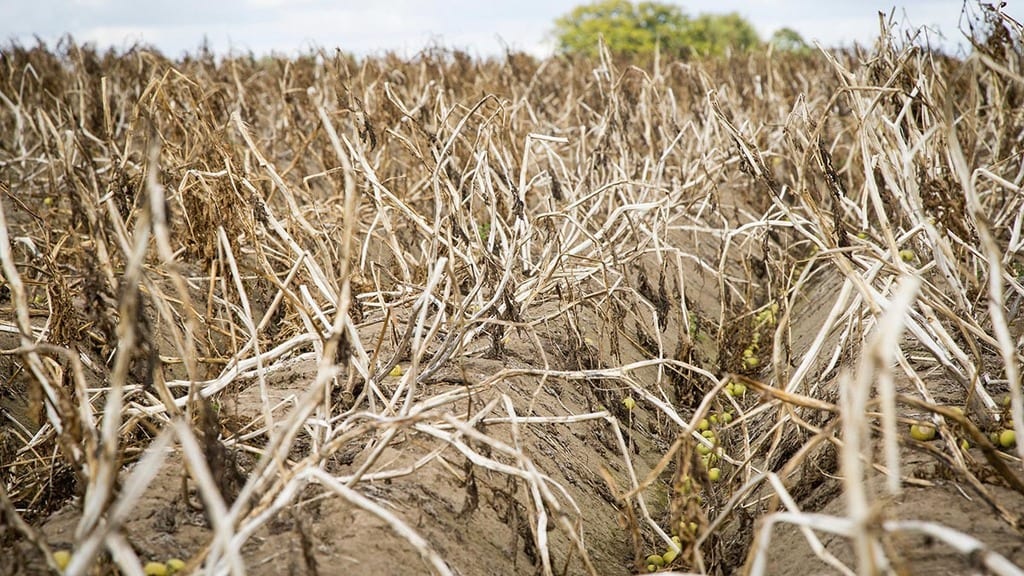
Top-kill vines at least two weeks before harvest. The vines should be completely dead before digging to reduce the risk of tuber infection. Infected green vines may be releasing late blight sporangia that can infect tubers at harvest. Tank mix Reglone with a copper fungicide to kill sporangia produced on infected tissue not killed by the desiccant.
Remember: An ounce of prevention is worth a pound of cure!



